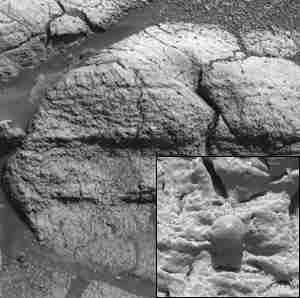Earth, Venus and Mars

Updated on
05/05/2015
|
Earth, Venus and Mars |
|
||||
| Home My Book Physical Geology Environmental Geology Oceanography |
|
|
|||
|
Updated on |
|||||
Water is abundant on the Earth, but not on Venus and Mars. This is because of their significantly different atmospheres and because of the presence or absence of plate tectonic activities.
|
|
|
|
|
|
|
||||||||||||||||||||||||
|
|||||||||||||||||||||||||
|
|||||||||||||||||||||||||
|
|||||||||||||||||||||||||
|
|
|
|
|
|
|
|
| 3 |
Two of the many images of Martian surface, obtained by Pathfinder and subsequent missions, that point to the role of running water in shaping the Martian landscape. |
|
||
|
NASA's 2001Mars Odyssey spacecraft returned this view of the south pole of Mars in intermediate energy or epithermal neutrons. Soil enriched in hydrogen is indicated by the deep blue colors, where a low intensity of epithermal neutrons is found. This view of Martian south pole comes from measurements made in the first week of Mars Odyssey's mapping, in February 2002. |
||||
| 4 | ||||
| NASA's Mars Exploration Spirit, as it started sending back images from the surface of Mars in an engineering feat that has been particularly remarkable | |
| because of problems in receiving signals from European Space Agency's British craft Beagle 2 . The overall scientific goal here has been to look for possibility of life, and the immediate goal has been to look for water, on Mars. Click on the picture for updates from JPL or here for the updates from BBC. | |
|
That water must have existed on Mars is also suggested
by the discovery of jarosite, a potassium iron sulfate hydroxide mineral
that was first found in Jaroso, Spain, and clearly points to the
planet's watery past. The problem is that this is
only an evidence of water-limited environment. The carbonate minerals that
would clearly suggest the existence of either an ocean or ocean-like
conditions on Mars remain as yet undiscovered. These images, taken by cameras on the Mars rover Opportunity, show a close-up of the rock outcrop dubbed "El Capitan," located in the rover's landing site, a crater at Meridiani Planum. Inset, a detail of the rock showing one of the tiny spherules, nicknamed "blueberries." NASA/JPL |
 |
|
As for plate tectonics on Mars (also click here), scientists have discovered magnetic stripes on the surface of Mars similar to fields in the sea floors of Earth that may be a result of ancient crustal spreading. The discovery is likely to revolutionize current thinking of the red planet's evolution. |
|
|
l This is because plate tectonics once occurred on Mars, but no longer does. Mars thus lacks hydrological cycle because it no longer has the plate tectonics to create new ocean basins to replace the ones flattened by the “run-off” component of hydrological cycle*. l The presence of hydrological cycle on the Earth, and its absence on Mars, is therefore due as much to the planetary atmospheres as to plate tectonics, while its absence on Venus is entirely ascribable to the structure and composition of Venutian atmosphere. |
![]()
* Seeking to answer this question by appealing to low density of Martian atmosphere, and argue that its temperature gradient is too gentle to have prevented the escape of atmospheric moisture (unlike Earth’s tropospheric thermal gradient that is steep enough to have retained the hydrological cycle), ignores the fact that a vigorous hydrological cycle may have once existed on Mars.
|
l The three planets have vastly dissimilar atmospheres. Earth’s atmosphere, a ~110 Km thick gaseous halo that encases the Earth, now comprises ~78% Nitrogen and ~21% Oxygen, but was nearly 90% CO2 until about 1.25 Ga ago. The atmosphere of Venus has 90 times the density of Earth’s atmosphere, and is ~95% CO2. Since this traps the Solar heat that is received on that planet’s surface, Venus is also called the “Greenhouse Planet”. Mars, on the other hand, has a very thin atmosphere. |
|||
|
l |
|||
|
that preclude any possibility for even the water molecule to exist. This renders moot any question of hydrological cycle on Venus. l As for Mars, there is good evidence that water was |
|||
|
|
l This is because plate tectonics once occurred on Mars, but no longer does. Mars thus lacks hydrological cycle because it no longer has the plate tectonics to create new ocean basins to replace the ones flattened by the “run-off” component of hydrological cycle*. l The presence of hydrological cycle on the Earth, and its absence on Mars, is therefore due as much to the planetary atmospheres as to plate tectonics, while its absence on Venus is entirely ascribable to the structure and composition of Venutian atmosphere. |
||
![]()
* Seeking to answer this question by appealing to low density of Martian atmosphere, and argue that its temperature gradient is too gentle to have prevented the escape of atmospheric moisture (unlike Earth’s tropospheric thermal gradient that is steep enough to have retained the hydrological cycle), ignores the fact that a vigorous hydrological cycle may have once existed on Mars.
|
l |
|
||||
![]()
* Seeking to answer this question by appealing to low density of Martian atmosphere, and argue that its temperature gradient is too gentle to have prevented the escape of atmospheric moisture (unlike Earth’s tropospheric thermal gradient that is steep enough to have retained the hydrological cycle), ignores the fact that a vigorous hydrological cycle may have once existed on Mars.